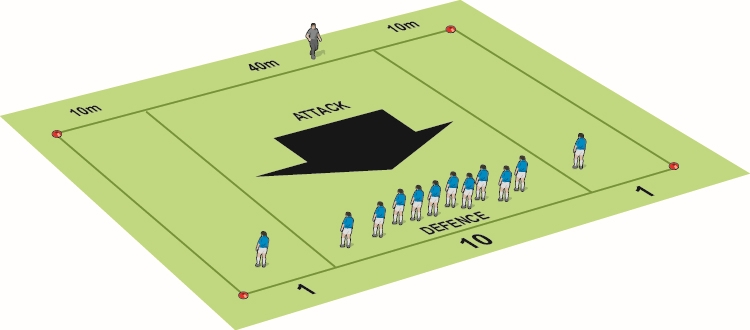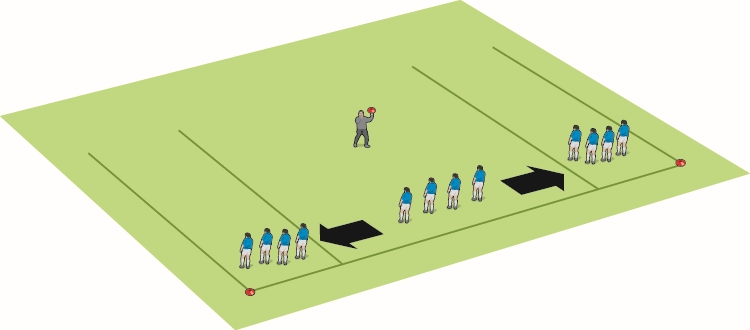Mike Hall: Running an U16 academy session
Attackby Dan Cottrell
Here’s how Mike Hall, formerly head of academy at Bristol, likes to put together an academy session for his U16 players at Bristol. Each session has two themes but we're going to look at one half of it – in this case, moving the ball into space.
Every session will have two themes that we’re working towards. For example, it might be moving the ball to space and ball presentation.
Let’s look just at the first of these themes – encouraging players to move the ball into space. In other words, compressing the defence into one area and then attacking where there are fewer defenders.
We let the game and session be the teacher. We won’t be giving players the answers, nor be asking questions to draw out the answers. It’s up to them to ask the questions themselves and of each other.
Although there’s an official start time, we want the players to be self-starters. They have to come and get the balls from us before the session begins. They should know what “work-ons” they should be concentrating on from previous feedback sessions.
Once we officially start, we play a game with one main constraint for 15 minutes and then add another main constraint after 15 minutes. We don’t warm up with stretches. If a player is stiff, he might loosen up himself before the session.


The second constraint (or variation) would entail the attack coach standing behind the defence. When he holds up a cone, the team would have to split evenly into each channel (see graphic 2). So if we’re playing 12 v 12, there would be four players in each channel.
During the main game, another coach will run breakout groups, which will be rotating in and out of the main game. As we’re focusing on moving the ball to space, here it would be 2 v 1s and 3 v 2s. See page 6 for a 3 v 3 exercise that we’d also run.
There’s lots of repetition, though we vary the angles of the defence and attack frequently. These skills can then be taken back into the game. In essence, we’ve isolated part of the pitch for the players where there has been some space created.
The session is quite intense. When players move from the game to the breakout and back again, we want them to self-organise. We shouldn’t be the ones asking if they’re ready to go.
Yes, we’ll need to be there to guide them, but ultimately we want them to be leaders, not us. The quieter we are, the more successful we’ll have been.
The randomness of the exercise is important because research shows that players are likely to retain the core skills involved over a long period of time if they practise them in different scenarios.
Every session will have two themes that we’re working towards. For example, it might be moving the ball to space and ball presentation.
Let’s look just at the first of these themes – encouraging players to move the ball into space. In other words, compressing the defence into one area and then attacking where there are fewer defenders.
We let the game and session be the teacher. We won’t be giving players the answers, nor be asking questions to draw out the answers. It’s up to them to ask the questions themselves and of each other.
START OF THE SESSION
Although there’s an official start time, we want the players to be self-starters. They have to come and get the balls from us before the session begins. They should know what “work-ons” they should be concentrating on from previous feedback sessions.
Once we officially start, we play a game with one main constraint for 15 minutes and then add another main constraint after 15 minutes. We don’t warm up with stretches. If a player is stiff, he might loosen up himself before the session.

- Play a 12 v 12 game where only one defender is allowed in each of the two wide channels. This is the first constraint
- The attack must pass the ball back into the middle channel if they’re touched in the wide channel

- To develop, the coach stands behind the attack holding a cone
- When you hold up the cone, the defence has to split evenly across all three channels. This is the second constraint
The second constraint (or variation) would entail the attack coach standing behind the defence. When he holds up a cone, the team would have to split evenly into each channel (see graphic 2). So if we’re playing 12 v 12, there would be four players in each channel.
BREAKOUT GROUPS
During the main game, another coach will run breakout groups, which will be rotating in and out of the main game. As we’re focusing on moving the ball to space, here it would be 2 v 1s and 3 v 2s. See page 6 for a 3 v 3 exercise that we’d also run.
There’s lots of repetition, though we vary the angles of the defence and attack frequently. These skills can then be taken back into the game. In essence, we’ve isolated part of the pitch for the players where there has been some space created.
The session is quite intense. When players move from the game to the breakout and back again, we want them to self-organise. We shouldn’t be the ones asking if they’re ready to go.
Yes, we’ll need to be there to guide them, but ultimately we want them to be leaders, not us. The quieter we are, the more successful we’ll have been.
The randomness of the exercise is important because research shows that players are likely to retain the core skills involved over a long period of time if they practise them in different scenarios.
Newsletter Sign Up
Coaches Testimonials

Gerald Kearney, Downtown Las Vegas Soccer Club

Paul Butler, Florida, USA

Rick Shields, Springboro, USA

Tony Green, Pierrefonds Titans, Quebec, Canada
Subscribe Today
Be a more effective, more successful rugby coach
In a recent survey 89% of subscribers said Rugby Coach Weekly makes them more confident, 91% said Rugby Coach Weekly makes them a more effective coach and 93% said Rugby Coach Weekly makes them more inspired.
Get Weekly Inspiration
All the latest techniques and approaches
Rugby Coach Weekly offers proven and easy to use rugby drills, coaching sessions, practice plans, small-sided games, warm-ups, training tips and advice.
We've been at the cutting edge of rugby coaching since we launched in 2005, creating resources for the grassroots youth coach, following best practice from around the world and insights from the professional game.













